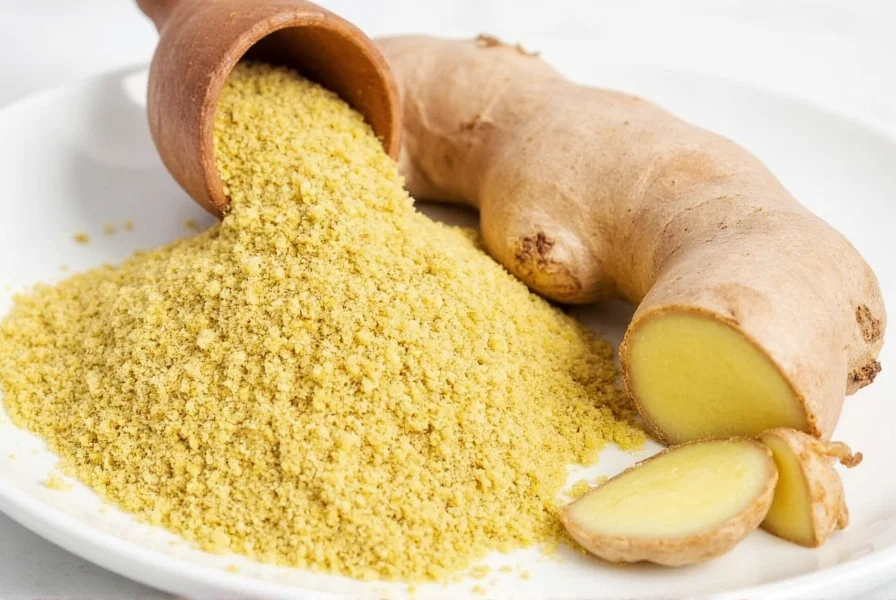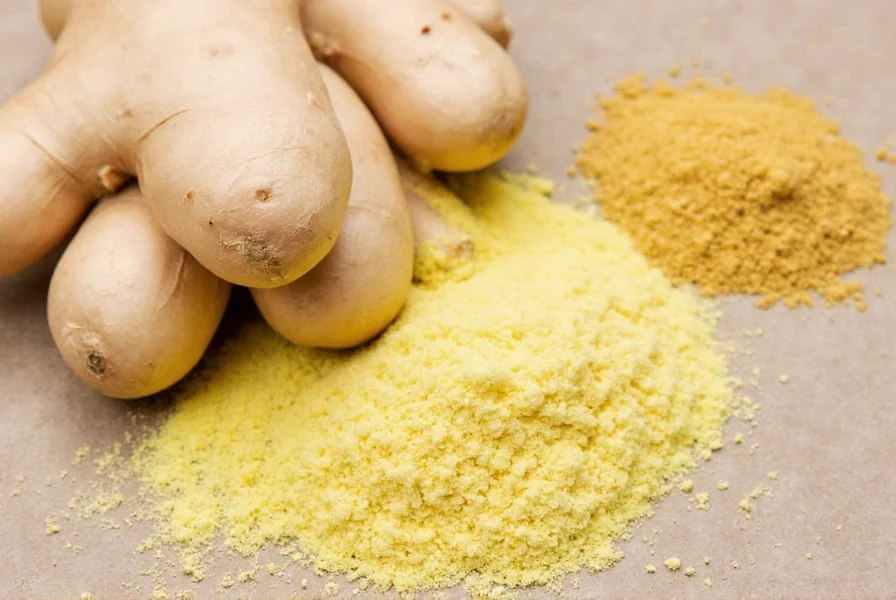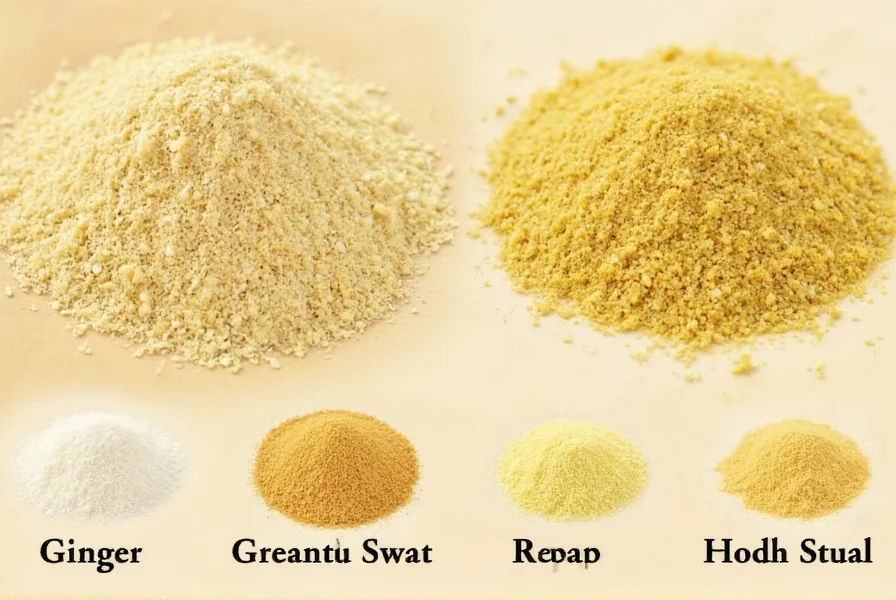The best substitutes for ground ginger include fresh ginger (use 1 tablespoon fresh grated ginger for every 1/4 teaspoon ground ginger), ginger paste (1:1 ratio), or a combination of cinnamon and cardamom (1/8 teaspoon each to replace 1/4 teaspoon ground ginger). For baking, allspice works well as a 1:1 replacement, while galangal provides a similar but sharper flavor profile in savory dishes.
When you're in the middle of cooking and realize you've run out of ground ginger, knowing reliable substitutions can save your recipe. This comprehensive guide explores practical alternatives that maintain flavor integrity while accommodating different cooking scenarios. Whether you're baking cookies, preparing curry, or mixing cocktails, understanding proper substitution ratios and flavor profiles ensures your dish turns out perfectly.
Understanding Ground Ginger and Substitution Needs
Ground ginger offers a warm, slightly sweet, and mildly spicy flavor that's essential in many recipes. Unlike fresh ginger, which has a brighter, more pungent taste, ground ginger provides consistent flavor distribution throughout dishes. Home cooks often need substitutes due to pantry shortages, dietary restrictions, or simply wanting to experiment with flavor variations.
When considering a ground ginger replacement, remember that substitution effectiveness depends on your specific recipe. Baking requires more precise measurements than savory cooking, where you can adjust flavors as you go. The moisture content of substitutes also matters—fresh ginger adds liquid that ground ginger doesn't, potentially affecting baked goods' texture.
Top 5 Substitutes for Ground Ginger with Conversion Ratios
| Substitute | Ratio (vs. 1 tsp ground ginger) | Best For | Flavor Notes |
|---|---|---|---|
| Fresh ginger, grated | 1 tbsp fresh = 1/4 tsp ground | Savory dishes, stir-fries, marinades | Brighter, more pungent flavor with citrus notes |
| Ginger paste | 1:1 ratio | Curry pastes, sauces, dressings | Concentrated ginger flavor, convenient for cooking |
| Allspice | 1/2 tsp allspice = 1 tsp ground ginger | Baking, spice cakes, cookies | Warm notes of cinnamon, nutmeg, and clove |
| Cinnamon + Cardamom | 1/8 tsp each = 1/4 tsp ground ginger | Oatmeal cookies, spice breads, chai | Warm spice blend mimics ginger's complexity |
| Galangal powder | 1:1 ratio | Thai curries, Southeast Asian dishes | Sharper, more peppery flavor than ginger |
Recipe-Specific Substitution Guidance
Not all substitutes work equally well across different types of recipes. Understanding which alternative works best for your specific cooking application ensures optimal results.
For Baking Projects
When substituting in baked goods like gingerbread, cookies, or spice cakes, allspice provides the closest flavor profile to ground ginger. Use half the amount of allspice as the ground ginger called for in your recipe. For a more complex flavor, combine equal parts cinnamon and cardamom—this ground ginger replacement works particularly well in oatmeal cookies and spice cakes.
Remember that fresh ginger adds moisture to baked goods, which can affect texture. If using fresh ginger as a ground ginger substitute in baking, reduce other liquids in your recipe by 1-2 teaspoons per tablespoon of fresh ginger used.
For Savory Cooking
In curries, stir-fries, and marinades, fresh ginger makes an excellent substitute for ground ginger. The 1:4 ratio (1 tablespoon fresh for every 1/4 teaspoon ground) works well, though you can adjust to taste since fresh ginger's potency varies. Ginger paste offers convenience with a 1:1 substitution ratio and dissolves easily into sauces.
For Thai or Indonesian dishes, galangal provides a similar but more intense flavor. Use it sparingly at first, as its sharper profile can dominate other flavors. When substituting galangal for ground ginger in curry recipes, start with half the amount and adjust to taste.
For Beverages and Syrups
When making ginger tea, cocktails, or syrups, fresh ginger works best as a ground ginger replacement. Simmer 1 tablespoon of freshly grated ginger per cup of liquid for 10-15 minutes to extract maximum flavor. For quick fixes, ginger paste dissolves easily in hot liquids at a 1:1 ratio.
Flavor Profile Considerations When Substituting
Each substitute affects your dish's final flavor differently. Understanding these nuances helps you choose the best ground ginger alternative for your specific recipe:
- Fresh ginger provides brighter, more citrusy notes with higher pungency
- Allspice offers warm, complex flavors reminiscent of cinnamon, nutmeg, and clove
- Galangal delivers a sharper, more peppery profile with subtle pine notes
- Spice blends create layered warmth without ginger's distinctive bite
When experimenting with ground ginger substitutes in recipes, start with less than the recommended amount, then taste and adjust. The goal isn't perfect replication but achieving a delicious final product that honors your recipe's intended flavor profile.
When Substitution Isn't Recommended
Some recipes rely so heavily on ground ginger's specific flavor that substitutes significantly alter the dish. Traditional gingerbread, certain Indian spice blends (like garam masala), and authentic Jamaican jerk seasoning work best with actual ground ginger. In these cases, consider making a quick trip to the store rather than substituting.
For health-focused recipes specifically designed around ginger's medicinal properties, substitutes won't provide the same benefits. Ground ginger contains concentrated gingerols that fresh ginger has in lower concentrations, so therapeutic recipes should use the specified form.
Storage Tips for Ground Ginger and Substitutes
Proper storage extends the shelf life of both ground ginger and its alternatives. Keep ground ginger in an airtight container away from heat and light—it maintains potency for 2-3 years. Fresh ginger lasts up to three weeks refrigerated in a paper bag, or frozen for up to six months.
Ginger paste stays fresh for one month refrigerated or six months frozen. Whole spices like allspice berries retain flavor longer than pre-ground versions—grind them fresh when needed for maximum potency as a ground ginger replacement.

Troubleshooting Common Substitution Issues
If your substitute makes your dish too spicy, balance with sweetness (honey or sugar) or acidity (lemon juice or vinegar). For baked goods that turn out too moist from using fresh ginger instead of ground, add 1-2 teaspoons of extra flour per tablespoon of fresh ginger used.
When your substitute lacks ginger's characteristic warmth, boost complementary spices like cinnamon or nutmeg. Remember that flavor develops over time—let savory dishes simmer longer to allow substitute flavors to meld, and give baked goods time to cool completely before evaluating spice balance.

Frequently Asked Questions
How much fresh ginger equals 1 teaspoon of ground ginger?
Use 1 tablespoon of freshly grated ginger to replace 1 teaspoon of ground ginger. The ratio is approximately 4:1 because fresh ginger contains moisture and has a milder concentrated flavor compared to the dried, powdered form.
Can I use allspice as a direct substitute for ground ginger in cookies?
Yes, but use half the amount of allspice compared to ground ginger. For example, if your cookie recipe calls for 1 teaspoon of ground ginger, use 1/2 teaspoon of allspice. Allspice provides similar warm notes but lacks ginger's distinctive bite, so you might want to add a pinch of black pepper for complexity.
What's the best ground ginger substitute for making curry?
Fresh ginger makes the best substitute for ground ginger in curry recipes. Use 1 tablespoon of freshly grated ginger for every 1/4 teaspoon of ground ginger called for. For Thai curries, galangal provides a closer flavor profile—use it at a 1:1 ratio but start with half the amount and adjust to taste as it's more potent.
Does ground turmeric work as a substitute for ground ginger?
Turmeric isn't a good flavor substitute for ginger, though it shares some visual similarity. Turmeric has an earthy, slightly bitter taste without ginger's warmth and spice. If you must use turmeric as a last resort, combine 1/4 teaspoon turmeric with 1/4 teaspoon cinnamon for every 1/2 teaspoon of ground ginger needed, but expect significantly different flavor results.
Can I make my own ground ginger from fresh ginger?
Yes, you can make homemade ground ginger by peeling and thinly slicing fresh ginger, then dehydrating it completely before grinding into powder. However, this won't perfectly replicate store-bought ground ginger as the drying process changes the flavor compounds. Commercially ground ginger undergoes specific processing that concentrates certain compounds, giving it a distinct warm flavor different from dried fresh ginger.











 浙公网安备
33010002000092号
浙公网安备
33010002000092号 浙B2-20120091-4
浙B2-20120091-4